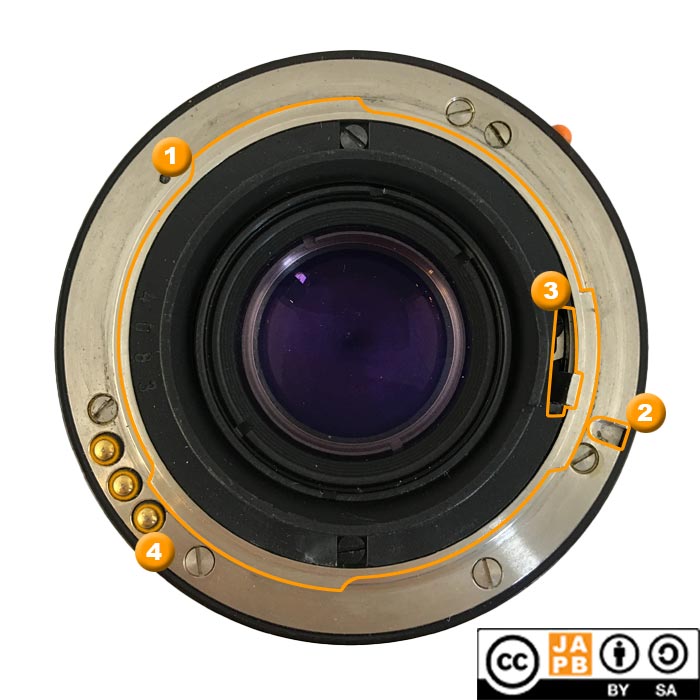Pekka Buttler (Updated 06/2025)
The Praktica B or Praktica Bayonet mount is the mount introduced 1978 and used by the Praktica B-series (B200, B100, BCX, BC1, BCA, BCC, BCS, BC3, BM, BMS, BX20, BX10, BX20s, BX21s) and lenses.
Praktica bayonet mount specifications and identification
Mount type: Bayonet (lens release on body)
Flange focal distance: 44,4 mm
Film format: 36mm x 24mm (‘Full frame’)
Mount communication: three electronic contacts to report the aperture selected by the user (lens-to-camera), one mechanical lever to stop down the lens for the shot (camera-to-lens)

Key characteristics of the mount of Praktica B lenses:
[1] Locking groove at roughly 03:45 o’clock.
[2] Three-pronged bayonet mount, 5 edges tapered (one straight)
[3] Stop-down lever
[4] (spring-loaded) Electronic contacts at 7:30 to 8:30 (always just three).
Basic Information on the Praktica bayonet mount:
The Praktica B-mount
Praktica (Pentacon) was not only the originator of the M42 thread mount (in some markets its was referred to as the “Praktica thread mount”), but remained one of the driving forces behind the development of the mount, and had taken an active role in trying to develop it further (see section on the electronic M42 mount in the JAPB article on the M42 mount). Pentacon also held on to the M42 mount long after most major camera manufacturers had deserted it in order to launch their own bayonet mounts. In the end (1978) also Pentacon admitted the inherent weakness of thread mounts, especially considering its limitations on camera-lens communication.
Interestingly, once Pentacon launched its own bayonet mount, this mount offered very few improvements over the capacities of the M42-electronic mount, that Pentacon had pioneered earlier. Even the electronic contacts had the same function (albeit spaced closer together). The two minor improvements were quicker, more secure mounting (inherent to bayonet mounts) and a quicker aperture stop-down (as long as the blades are dry and the spring is fully functional).
One can only speculate about the final fate of the Praktica B -mount, Pentacon, and the entire East German camera industry, as the reunification of Germany put an end to the production of Praktica cameras and led to a series of closures and re-amalgamations of East german optical companies. Would one indulge in speculation, one would have to consider the long decline of Praktica market share, and the relative slowness of east-bloc companies embracing novel concepts such as zoom lenses or electronics in cameras. Even so, there seen to have been some plans toward developing a high-end autofocus SLR, but whether those would ever had reached fruition (even without the GDR collapsing) is anyone’s guess.
So – you might ask – why care about the Praktica B mount at all? The answer is relatively simply, that the Praktica B -mount typically offers the most modern versions of classic East German designs (Flektogon, Pancolar, anyone?).
Furthermore, while obviously some of the designs offered by Pentacon and Carl Zeiss Jena (e.g. Pentacon Prakticar 50/1.8) are quite pedestrian, they are by no means below-average (legacy) lenses. There is therefore ample reason to have a lasting interest in the mount and its glassware.

Top right: CZJ Prakticar (Flektogon) 35 mm f/2.4
Lower left: CZJ Prakticar (Flektogon) 20 mm f/2.8
Lower right: CZJ Vario-Prakticar (Vario-Pancolar) 35-70 mm f/2.7-3.5
Note, please: The East German camera industry was not alone in producing lenses for the Praktica B mount, as both the Japanese and Korean optical industries contributed. Still, what makes the Praktica B mount interesting are not Sigma’s or Samyang’s contributions to the line-up.
Adapting Praktica bayonet lenses
With the flange focal distance of the Praktica B mount being a relatively short 44,4 mm, adapting Praktica B-mount lenses has realistically only become feasible after the advent of mILC’s. As with most lenses originally designed for 35 mm film, they are ideally adapted on full-frame sensor cameras, exacerbated by that (currently) no focal reducers are available (or usable) for Praktica B-mount lenses. Once a suitable adapter has been purchased, their functionality is unproblematic, as they function totally manually.
Read more:
• A lot of gold on Praktica B lenses (mostly in German) on zeissikonveb.de
• Tiago Franco’s site on the Praktica B system